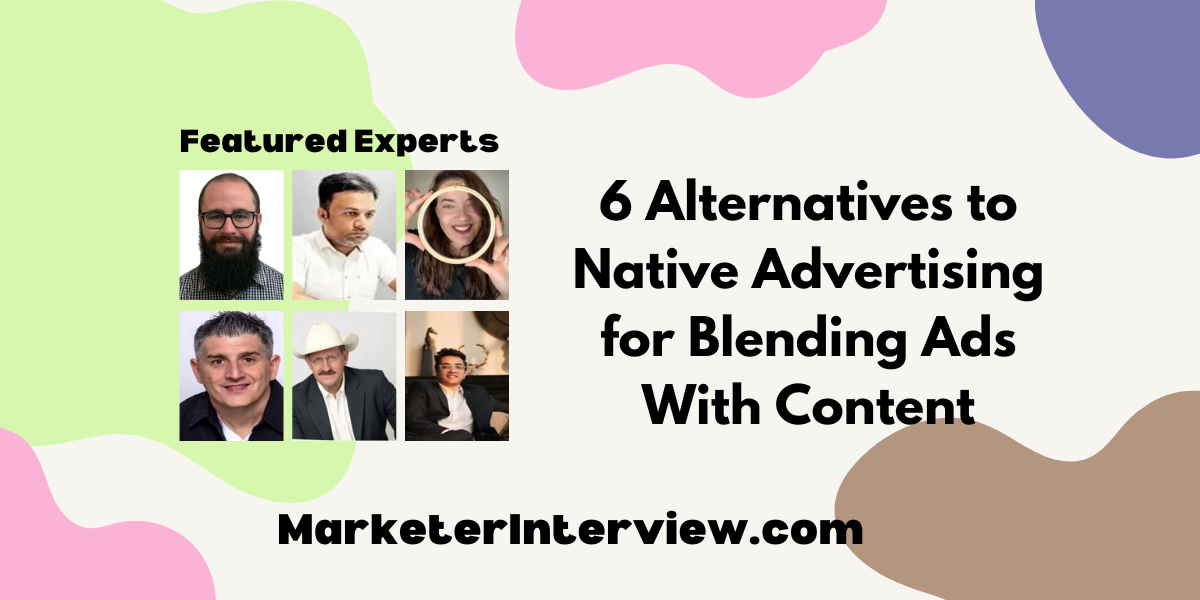6 Alternatives to Native Advertising for Blending Ads With Content
To explore alternatives to native advertising for seamlessly blending ads with content, we asked marketing professionals and CEOs for their expert suggestions. From leveraging newsletter ads for targeted reach to using LinkedIn sponsored content, here are six specific alternatives these leaders recommend.
Want to get quoted in MarketerInterview.com content just like this? Apply to become a contributor today!
Contents
Leverage Newsletter Ads for Targeted Reach
One effective alternative to native advertising for integrating ads with content is newsletter ads. Unlike traditional banners or pop-ups, newsletter ads seamlessly fit within the context of curated content delivered directly to subscribers’ inboxes. These ads typically mimic the newsletter’s style and tone, ensuring they feel organic and relevant to the audience.
I suggest leveraging newsletter ads because they offer a targeted approach, reaching subscribers who have already shown interest in the content and are likely to engage with related products or services. By aligning the ad content with the newsletter’s theme or topic, advertisers can enhance relevance and effectiveness without disrupting the user experience.
Additionally, newsletters often have a loyal readership, making them an ideal platform for promoting products or sharing valuable content in a non-intrusive manner.

Fahad Khan, Digital Marketing Manager, Ubuy India
Sponsor Branded-Content Series
Branded-content series, such as podcasts or video series, offer an alternative to native advertising by creating an ongoing relationship with the audience. By sponsoring a series that explores topics relevant to both the brand and its target audience, companies can subtly integrate their products or services into each episode. This format not only keeps the audience engaged over a longer period but also builds brand affinity through repeated exposure in a context that adds value to the viewer’s or listener’s experience.

Jason Hennessey, CEO, Hennessey Digital
Provide Educational Content
Educational content is an excellent alternative to native advertising because it allows brands to provide real value to their audience while subtly integrating their products or services. By creating tutorials, how-to guides, webinars, or workshops, you can become an expert, providing invaluable information to your customers or clients.
This approach engages users and showcases the practical applications and benefits of a brand’s offerings in a natural and informative manner. For instance, we create detailed sewing tutorials that not only teach our audience new skills but also highlight our high-quality fabrics and tools. This method creates that connection with our customers, as they feel they are gaining valuable knowledge rather than being subjected to overt advertisements.
A multitude of businesses can adopt this strategy to effectively blend ads with content. A tech company, for example, can offer coding workshops that feature their software products, while a beauty brand can produce skincare routines demonstrating their product line. Even service-based businesses can create webinars or e-books addressing common industry challenges and presenting their services as solutions.
The key is to focus on delivering genuinely helpful content that addresses the needs and interests of the target audience. By doing so, brands can naturally integrate their products or services, creating a seamless and engaging experience that builds credibility and fosters customer loyalty.

Gabriela Statie, Founder, Makenstitch
Partner for Content Sponsorship
One alternative to native advertising is content sponsorship. This involves partnering with creators or publishers to produce content that aligns with your brand’s values and message, but with the creator’s unique voice and audience in mind. Unlike native ads that mimic the platform’s content, sponsored content is openly labeled as sponsored, yet offers value-driven or entertaining material closely related to the sponsor’s products or services.
I suggest identifying influencers or content platforms that share your target audience and proposing a collaboration to produce content that entertains, informs, or educates, with a subtle integration of your brand. For example, sponsoring a podcast episode relevant to your industry and having a brief mention of your brand at the beginning and end can effectively blend ads with content while keeping the audience engaged.

Kartik Ahuja, Digital Marketer, kartikahuja.com
Create In-Depth Articles and Videos
In our firm, we’ve found that producing in-depth articles and YouTube videos can be a powerful way to blend promotional content with valuable information. We create comprehensive pieces on topics like “What is the Life Expectancy of Mesothelioma?” or “Who Is Eligible to File a Gardasil Vaccine Lawsuit?” These aren’t direct ads, but they naturally highlight our expertise.
For instance, we might publish a long-form article on our blog or a respected legal website, diving deep into the legal precedents of asbestos litigation. Or we could create a YouTube video where our attorneys explain complex legal concepts in simple terms. These pieces provide real value to our audience while subtly introducing our firm as a go-to resource. The key is to prioritize informative content over overt promotion.
We’ve found this approach builds trust more effectively than traditional ads. It also has staying power—people tend to bookmark informative articles or save videos for future reference. By mixing helpful content with our marketing message, we’re able to connect with potential clients in a way that feels more genuine and less pushy than typical advertising.

Johnny Cargill, Marketing Director, The Lanier Law Firm
Use LinkedIn Sponsored Content
Sponsored Content on LinkedIn is a powerful way to engage with a professional audience directly in their newsfeed. These ads are designed to mirror the format of regular posts, making them less disruptive and more engaging. They can include various formats like single images, videos, carousel ads, and even event promotions, offering flexibility to match different marketing goals.
What makes LinkedIn Sponsored Content particularly effective is its ability to target a specific audience based on professional attributes such as job title, industry, and company size. This ensures your content reaches the most relevant users, increasing the likelihood of meaningful engagement.
By leveraging Sponsored Content in the LinkedIn newsfeed, you capture users’ attention as they browse, naturally integrating your promotional material into their feed. This approach is especially effective for B2B marketing, where you can promote thought-leadership content, industry insights, or product updates that align with the interests of LinkedIn’s user base. The key to success with Sponsored Content is to provide value, ensuring your ads resonate with the professional audience and blend seamlessly with their browsing experience.

Léo Pinon, International Marketing Strategist, Go Fish Digital
Want to get quoted in MarketerInterview.com content just like this? Apply to become a contributor today!






